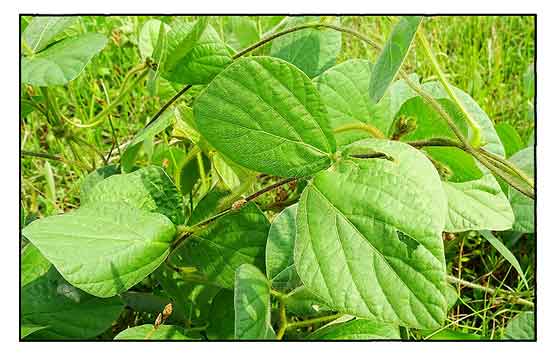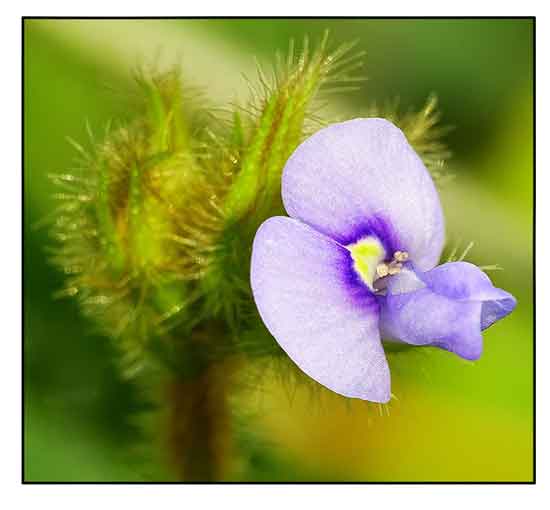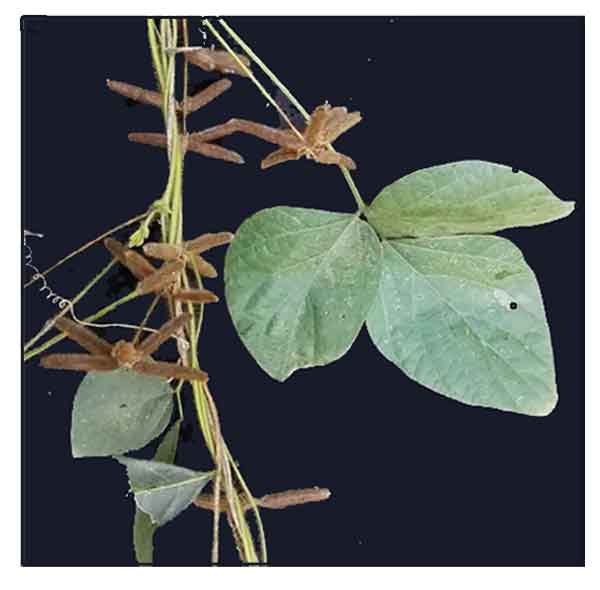 Gen info Gen info
- Calopogonium mucunoides is a species of flowering plant in the family Fabaceae, native the New World Tropics, and introduced as a forage crop and green manure the tropics of Africa, Madagascar, the Indian Subcontinent, Asia, Malesia, Papuasia, and Australia. (2)
Botany
• Calopogonium mucunoides is a vigorous, creeping, twining or trailing herb, up to several m long, forming a tangled mass of foliage 30-50 cm deep, with densely pilose stems with long spreading ferruginous hairs. Leaves trifoliolate, petiole up to 16 cm long, pilose; leaflets elliptical, ovate or rhomboid-ovate, (1.5-)4-10(-15) cm × (1-)2-5(-9) cm, the laterals oblique, adpressed pilose or pubescent on both surfaces. Inflorescence a slender raceme, up to 20 cm long, peduncle 0-17 cm long, ferruginous pilose. Flowers in fascicles of 2-6, blue or purple; calyx campanulate, unequally 5-lobed; corolla with emarginate standard, about 1 cm long. Pod linear-oblongoid, 2-4 cm × 3.5-5 mm, straight or curved, softly pilose with coarse reddish-brown hairs, impressed between the seeds, 3-8 seeded. Seed compressed squarish, 2-3 mm long, yellowish or reddish-brown. (2)
 • Herbs, twining or procumbent, densely hirsute with spreading fulvous hairs. Stipules triangular-lanceolate, 4-5 mm; petiole 4-12 cm; stipels subulate; terminal leaflet ovate-rhombic, lateral ones obliquely ovate, 4-10 × 2-5 cm, broadly cuneate to rounded at base, acute or blunt at apex. Inflorescences 1-10 cm; flowers 5 or 6, clustered at nodes of rachis; bracts and bracteoles linear-lanceolate, ca. 5 mm. Calyx tube glabrescent; lobes longer than tube, linear-lanceolate, densely appressed hirsute, long acuminate at apex. Corolla purplish; wings obovate-oblong; keel straight, with short auricles. Ovary densely hirsute. Legumes linear-oblong, 2-4 cm × ca. 4 mm, straight or slightly curved, with appressed long brown bristles, 5- or 6-seeded. Seeds ca. 2.5 × 2 mm. (Flora of China) • Herbs, twining or procumbent, densely hirsute with spreading fulvous hairs. Stipules triangular-lanceolate, 4-5 mm; petiole 4-12 cm; stipels subulate; terminal leaflet ovate-rhombic, lateral ones obliquely ovate, 4-10 × 2-5 cm, broadly cuneate to rounded at base, acute or blunt at apex. Inflorescences 1-10 cm; flowers 5 or 6, clustered at nodes of rachis; bracts and bracteoles linear-lanceolate, ca. 5 mm. Calyx tube glabrescent; lobes longer than tube, linear-lanceolate, densely appressed hirsute, long acuminate at apex. Corolla purplish; wings obovate-oblong; keel straight, with short auricles. Ovary densely hirsute. Legumes linear-oblong, 2-4 cm × ca. 4 mm, straight or slightly curved, with appressed long brown bristles, 5- or 6-seeded. Seeds ca. 2.5 × 2 mm. (Flora of China)
Distribution
- Introduced.
- In some locales, it has becomes a serious invasive species.
- Native range is Mexico to Tropical America.
 Constituents Constituents
- Phytochemical screening of methanol extract of leaves yielded alkaloids, anthocyanins, flavonoids, glycosides, reducing sugars, saponins, steroids, tannins, and terpenoids. (6)
- Heavy metals analysis revealed presence of lead (0.08 mg/kg) and iron (0.08 mg/kg) well below the acceptable limits set by the WHO for heavy metals in plants. (6)
- Study of aerial parts showed total phenolic content (4.29mg/g). Proximate analysis showed high protein content (18.62%), and carbohydrate content (21.56%). (see study below) (5)
- Study of dichloromethane-methanol (1:1) soluble part extract of C. mucunoides isolated 10 isoflavones viz., 4′-O-methylalpinumisoflavone (1), 4′-O-methylderrone (2), alpinumisoflavone (3), daidzeine (4), Calopogonium isoflavone A (5), atalantoflavone (6), 2′,4′,5′,7-tetramethoxyisoflavone (7), 7-O-methylcuneantin (8), cabreuvin (9) and 7-O-methylpseudobaptigenin (10) and a rotenoid (6a,12a-dehydroxydegueline). (see study below) (9)
- Phytochemical analysis of leaves yielded alkaloids, terpenoids, tannin, flavonoids, saponin, with absence of glycosides and steroids. (see study below) (10)
Properties
- An extremely vigorous climber. It can form dense mats to smother other vegetations.
- Studies have suggested antioxidant, antimicrobial, nutrient, antidiarrheal, antiulcer, urease inhibitory, mosquito larvicidal properties.
Parts used
Leaves.
Uses
Edibility
-Fruits are e
Folkloric
- In Benguet, used for treatment of goiter and for wound healing. (11)
- In Nigerian folk medicine, leaves used for treatment of ulcers, bacterial infections, diarrhea, skin diseases, and scurvy. (6)
Others
- Cover crop: An important cover crop for plantation crops, especially rubber and oil palm, used alone or in mixture with two other cover crops i.e., centro (Centrosema pubescens) and kudzu (Pueraria phaseoloides). (2)
- Agrofrestry: Used as green manure. A valuable pioneer legume that protects the soil surface, reduces soil temperature, fix atmospheric nitrogen, improve soil fertility and control growth of weeds. (2)
- Forage: Cattle forage for dry seasons when more palatabl species are scarce. It can be grazed or cut and fed fresh. It can yield up too 14 t DM/ha is harvested in a single cut when pods are already mature When cut every 9-12 weeks, DM yields are about 4-6 t/ha. (12)
Studies
• Cover Crop / Effect on Nitrogen: Study reports of the effects of three common Philippine Cover Crops viz., Calopogonium mucunoides, Centrosema pubescens, and Pueraria javanica.
• Antimicrobial / Leaves: Study evaluated the phytochemical, heavy metals, and antimicrobial activity of leaves of C. mucunoides. The extracts were tested against thirteen human pathogens (10 bacteria and three fungi) using disk diffusion method. Results showed a broad range of microbial activities, with the methanolic extract showing highest zone of inhibition (31mm) against Bacillus sp. (see constituents above) (6)
• Antioxidant / Aerial Parts: Study of aerial parts showed total phenolic content (4.29mg/g). Methanolic extract showed highest antioxidant activity (67-71% inhibition). Proximate analysis showed high protein content (18.62%), and carbohydrate content (21.56%). Results showed high nutritional value, especially the high protein and fiber content, with potential for use in feed formulation. (5)
• Anti-Ulcer / Leaves: Study evaluated the phytoconstituents, acute toxicity, and antiulcer effect of ethanol extract of leaves using ethanol-inducd gastric ulceration model in rats. The extract at high dose of 5000 mg/kbw was not toxic. At doses of 100 and 300 mg/kbw, the extracts showed significant (p<0.05) dose-dependent reductions in volume of gastric juice secretion ulcer index,, and concentrations of free and total acidity in treated rats. The anti-ulcer effect was comparable with that of standard anti-ulcer drug ranitidine. (7)
• Antidiarrheal / Antibacterial / Leaves: Study evaluated the antidiarrheal and antibacterial activities of ethanol extract of leaves in albino rats. Antidiarrheal study showed the extract significantly protected (p<0.05) the rats against castor-oil induced diarrhea, inhibited gastrointestinal transit, reduced frequency of defecation in the treated group. The crude ethanol extract as well as flavonoid and alkaloid contents showed good concentration-dependent antibacterial activity against the test organisms viz., E. coli, S. typhimurium, S. aureus, and B. cereus. (8)
• Urease Inhibitory Isoflavonoids / Antibacterial / Leaves: Study of dichloromethane-methanol (1:1) soluble part extract of C. mucunoides isolated 10 isoflavones. Of the isolated constituents, nine were evaluated for urease inhibitory potential. Six were found potent viz., 4′-O-methylderrone, daidzeine, atalantoflavone, 2′,4′,5′,7-tetramethoxyisoflavone, 7-O-methylcuneantin and 6a, 12a-dehydroxy-degueline. (Urease inhibitors have potential as antiulcer drugs.) (see constituents above) (9)
• Larvicidal Against Aedes aegypti / Leaves: Study evaluated the larvicidal efficacy of C. mucunoides leaf and Chrysophyllum albidum seed extract against 2nd and 3rd larval instars of Ae. aegypti. Lethal concentrations (LC50 and LC90) for C. mucunoides were 2.935 and 7.608 ppm, 2.096 and 6.302 ppm, and 1.626 and 5.866 ppm for 24 h, 48 h, and 72 h (2nd instar larvae), and 2.923 and 11.067 ppm, 2.096 and 9.686 ppm, and 2.033 and 6.946 ppm (3rd instar larvae). The chloroform fraction of C. mucunoides partitioning showed 100% mortality for 3rd instar larvae, with the leaf extract showing more potency than C. albidum seed extract. Results suggest potential as substitute for conventional insecticides and synthetic pesticides and control of mosquito larvae. (10)
Availability
Wild-crafted. |

![]()






